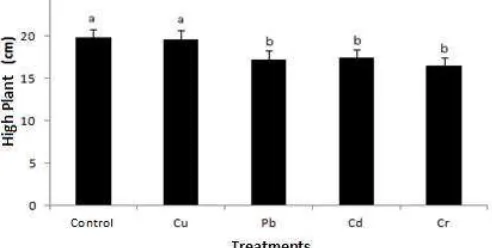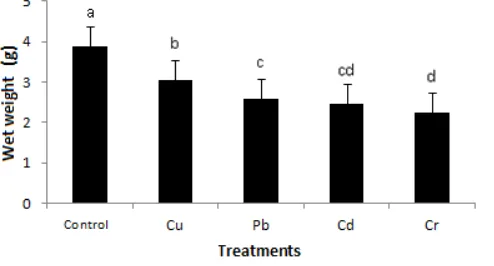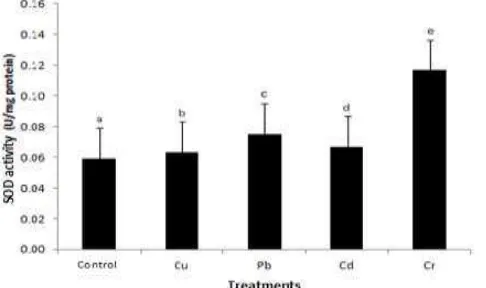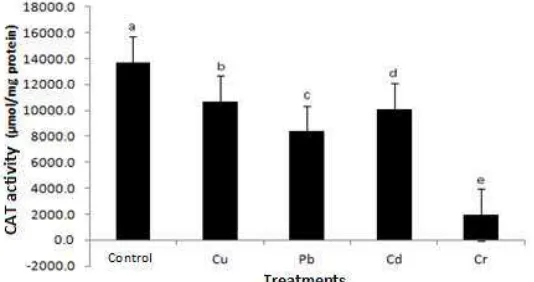The Growth and Antioxidative Responses of
Sonchus
oleraceus
Under Cu(II), Pb(II), Cd(II) and Cr(VI) Stress
Condition
Hidayaturrohmah N, Kasmiyati S
a. and Sucahyo
Fa culty of Biology, Sa tya Wa cana Christian University, Sa latiga , Indonesia
a
Corresponding author: [email protected]
Abstract
The rapid pace of growth pose a real impact in the form of increased heavy metal waste that causes environmental pollution. Heavy metals that contaminate the soil are chromium(Cr), lead(Pb), cadmium(Cd), copper(Cu). The plant that grow in soil containing heavy metals will be stunted, and can increase the produvtion of Reactive Oxygen Species (ROS). In dealing with the excess amount of ROS, plants have an enzimatic defense system, by using superoxide dismutase (SOD), catalase (CAT), and ascorbate peroxide (APX). The aim of this study was to
determine and analyze the Sonchus oleraceus plant response to heavy metals stress, seen from the growth and
antioxidative defense enzymatically. Research carried out experimentally using a Completely Randomized Design (CRD) with four treatments and five replications. The metal concentrations given are 10 ppm. The presence of
heavy metals in the growing medium significantly decreased the plant height and Sonchus oleraceus leaf area, so the
impact is on the weight of wet and dry weight. The toxicity of Cr, Cd, Pb and Cu increases the activity of SOD and APX enzymes, but decrease the activity of the CAT enzyme. Chromium is a metal that has significant influence on
the growth and activity of SOD, APX, and CAT enzymes in Sonchus oleraceus.
Keywords: Heavy metal, Sonchus oleraceus, growth, antioxidative responses
Introduction
Heavy metal pollution is one of the problems of the environment in which the presence of a metal in the soil, air and waters exceeds the threshold and being toxic. Heavy metal is an element that has a density of more than 5 g/cm3 [1]. Heavy metals are naturally contained in the soil but can also come from agricultural and industrial waste as well as the burning of transportation. On soil, heavy metal pollution lead to various problems including the disruption of the growth of soil organisms and plants as well as the problems associated with aesthetics (discoloration and odor) [2].
chlorophyll thereby reducing biomass [6]. Whereas Cr accumulation can increase the activity of antioxidative enzymes and decrease the rate of growth in Shorgum plants [7-8].
The plasma membrane is the first part that is in direct contact with heavy metals, so that it will disrupt the absorption of other essential elements. Along with the heavy metal absorption of nutrients and water uptake by plant roots, then the compound will accumulate to plant's parts such as roots, stems, and leaves [9]. The presence of heavy metals can disrupt metabolic processes and developmental germination [10]. Heavy metals cause the decrease of leaf area and plant dry weight, root plasma membrane damage, a decrease in photosynthetic activity and the growth of bean plants [11]. Heavy metal also affects the lowered spinach plant leaf area, causing the death of cells in the leaf tips and leaf growth rate slows [12].
Heavy metal toxicity in plants are also associated with the produced of ROS (Reactive Oxygen Species) which reached 30times higher than normal conditions [13]. ROS are oxygen derivatives oxidizing compounds that are highly reactive. ROS can be H2O2 (hydrogen peroxide), O2 (superoxide
radicals), OH (hydroxyl radical), Ho2 (hydrogen oxide radicals), etc [14]. Under normal conditions, ROS
are produced in low quantities in the cell organelles, but when the amount exceeds the amount of ROS increases antioxidative defense, it can cause a condition called oxidative stress. ROS can damage the membrane and react with biomolecules, thereby disrupting normal cellular structure and function are indicated by abnormalities (symptoms) [15].
Antioxidant defenses needed to reduce oxidative damage from ROS. The defense can be enzymatic and non-enzymatic [16]. In enzymatically for example using enzymes superdioxide dismutase (SOD), catalase (CAT) and ascorbate peroxidase (APX). Balance the activity of SOD, CAT and APX are important in suppressing ROS in cells. SOD is an initial defense against ROS, followed by CAT and APX work [17]. SOD functions to change the O2 into H2O2. CAT works to change the H2O2 into H2O and O2.
APX function converts H2O2 into H2O and MDHA (monodehidroaskorbat) [18]. Oxidative defense
becomes an important mechanism for plants tolerant to fight heavy metal stress, because the plant cannot move so susceptible to heavy metal stress in their habitat.
Sonchus olera ceus or known as tempuyung is a weed that is included in the annual plant that grows wild in the area with an altitude of 200-2200 meters above sea level in areas exposed to sunlight and a little shade. This plant is used as food and medicine. Sonchus oleraceus can be used as test plants as easily obtained and grown, its life cycle is relatively short at around 3 months and widely used as a medicinal plant for diseases such as inflammation, kidney stones and blood purifier.
The research using Sonchus oleraceus the treatment of heavy metal is still rare. Most of it only research on the content of Sonchus oleraceus for use as a medicine. The aim of this study was to determine and analyze the plant response to stress Sonchus oleraceus heavy metals, in terms of the growth of and enzymatic antioxidative defense.
Materials and Methods
The planting of seeds of Sonchus oleraceus and preparation of test plants
The germinated seeds in one pot using a mixture of soil and compost medium with a ratio of 1: 1. After 30 days, the test plants were selected based on height and number of leaves uniform. Test plant was moved in polythene bags containing soil medium, one polybag one plant, then acclimatized for 7 days.
The treatment of heavy metal stress
Cr, Cd, Cu and Pb concentrations of 10 ppm are given at the beginning of treatment. Heavy metal compounds used are K2Cr2O7, CdCl2, CuSO4 and Pb(CH3COO)2 obtained from the laboratory of
biochemistry and Molecular Cell Biology, Faculty of Biology, Satya Wacana Christian University, Salatiga. The solution of heavy metals are provided on each polybag (500 g soil) as many as 50 ml. Treatment was given for 30 days. During the treatment period, each of the plants are watered using tap water 20 ml.
The measurement of plant growth
The growth measured by plant height, number of leaves, leaf area, and dry weight and wet weight. Measurements of plant height and number of leaves is done during the treatment, while the leaf area, fresh weight and dry weight at the end of the treatment time.
Plant’s Height
Plant height measurements performed every two days. Plant measured from the base of the stem to the highest branches of plants.
Numbers of leaves and Leaf area
Observation of the number of leaves every two days. Whole leaf is calculated including dried and withered, except the leaves are still buds. Leaf area was measured by gravimetric methods, principally through the leaf area estimated weight ratio. The measures undertaken which is draw on the fifth leaf buds on a piece of paper which produces replicas of leaves. Then cut leaf replica leaf area was estimated based on the following equation [19]:
LD = ��
�� x LK
Description: LD = Broad Leaf
Wr = weight paper replicas of leaves Wt = total weight of paper
LK = The total area of the paper
Dry weight and Wet weight
Antioxidative enzyme activity measurements Enzyme sample preparation
Extraction of antioxidative enzymes using methods Sunkar [20]. A total of 200 mg of wet second and third leaves from the shoots were mixed with 1.5 ml of extraction buffer, which is 0.2 M sodium phosphate (pH 7.8) containing 0.1 mM EDTA. Pulverized using a mortar and pestel, then centrifuged at 15,000 g for 20 minutes at 40 C. Supernatant was used for determination of the activity of SOD, CAT, and APX.
Superoxide Dismutase (SOD)
A total of 20 µl enzyme extract and 20 µl of 1 mM riboflavin was added in 1.5 ml of the reaction mixture. The reaction mixture in the form of 50 mM sodium phosphate buffer (pH 7.8) containing NaH2PO4.2H2O and Na2HPO4.I2H2O; 0.2 ml EDTA 2mM; methionine 9.9 mM; Nitroblue tetrasolium (NBT) 55 µM; and 0.025% Triton X100. The reaction begins when riboflavin is added to the mixture, then placed under fluorescent light 15 Watt at a distance of 20 cm for 10 minutes. The reaction was stopped by turning off the lights and closing the tube with less black plastic. Shells and controls used are the same reaction mixture, but the sample was replaced with phosphate buffer, and then placed in a dark place for the blank and the light to control. Absorbance was measured at a wavelength of 560 nm using a spectrophotometer (Shimadzu UV-vis mini 1240). SOD activity is determined by the amount of enzyme that produces 50% inhibition of NBT reduction photo formazen formed by O2-. One unit of enzyme
activity is expressed by the amount of enzyme that reduces the absorbance of up to 50% of control. Enzyme activity is expressed in units per gram of wet weight (WW).
SOD activity (U / grams WW) = (absorbance control-absorbance of the sample): absorbance of control: 50% X volume of mixture: concentration of the enzyme protein.
Catalase (CAT) and Ascorbat Peroxydase (APX)
The 3 ml assay mixture contained 1,99 ml sodium phosphate buffer (pH 7.0), 10 µl enzyme extract and 1 ml H2O2 12,058 mM, for CAT measurement. Absorbance was measured at a wavelength of
240 nm using a spectrophotometer (Shimadzu UV-vis mini 1240). The extinction coefficient of H2O2 (40
mM-1 cm-1 at 240 nm) was used to calculate the enzyme activity that was expressed in terms of millimoles of H2O2 per minute per gram fresh weight. expressed in terms of millimoles of ascorbate per minute per gram fresh weight.
CAT and APX enzyme activity was determined using the following equation.
Data Analysis
Data were analyzed using One-Way ANOVA at 5% significance level to determine the effect of treatment on each parameter. Turkey continued testing to determine the mean or average mutually significantly different. The program used was SPSS 17.0 software.
Result
Sonchus oleraceus leaf morphology after exposure to heavy metals for 30 days showed different results (Figure 1). Visually, the leaves on the plant by exposure to Cu look normal and green, not much different from the metal leaves that are not given heavy metal (control). While the leaf is exposed to a yellowish-green colored metals Pb, Cd metal exposed leaves are pale green and wrinkled. In contrast to the leaves by exposure to Cr, green-purple color of the leaves and the leaves are dried.
Figure 1. The second leaf of Sonchus olera ceus on heavy metal stress conditions
High growth of plants Sonchus oleraceus with heavy metals Cu treatment was not significantly different to the control plants, while the plants are both significantly different from that given exposure to Pb, Cd and Cr.
Figure 2. High Sonchus olera ceus plants in heavy metal stress conditions. The notationa,b show a significant difference (p≤0.05) between treatments.
Figure 3. Number of leaves Sonchus olera ceus on heavy metal stress conditions.
The treatment of heavy metals showed significantly different results in leaf area Soncgus oleraceus. Control plants had an average of greatest leaf area followed by a treatment plant with Cu, Pb, Cr and Cd adalan smallest.
Figure 4. Leaf area Sonchus olera ceus on heavy metal stress condition notationa, b, c, d show a significant difference (P≤0.05) between treatments.
Wet weight and dry weight of plants Sonchus oleraceus significantly different at each treatment of heavy metals, except control and Cu on a dry weight parameters. Both have the same downward trend. Cr exposure causes decreased Sonchus oleraceus high, followed by exposure to Cd, Pb and Cu.
Figure 5. The weight of wet plant Sonchus olera ceus on heavy metal stress conditions. The notation a, b, c, d show a significant
Figure 6. The dry weight of the plant Sonchus olera ceus on heavy metal stress conditions. The notation a, b, c, d show a significant
difference (P≤0.05) between treatments.
The treatment of heavy metals Cu, Pb, Cd and Cr overall have significant effects on the enzyme activity of SOD. SOD activity in plants treated with heavy metals all increased compared to control plants. The SOD activity is in Sonchus oleraceus with exposure to Cr increased 97.3%, followed by the plant with exposure to Pb, Cd and Cu with the percentage increase respectively by 27.2%, 13.4% and 6.8%.
Figure 7. The SOD activity Sonchus olera ceus plants in heavy metal stress conditions. The notation a, b, c, d, e shows a significant difference (P≤0.05) between treatments.
Figure 8. Activity APX Sonchus olera ceus plants in heavy metal stress conditions. The notation a, b, c, d show a significant difference (P≤0.05) between treatments.
Unlike the enzyme SOD and APX, CAT enzyme activity in plants by exposure to heavy metals had a significant reduction compared to the control. Plant Sonchus oleraceus with exposure to Cr has the smallest CAT enzyme activity with a decrease of 85.9%. Followed by a decline in CAT activity in plants exposed to Pb, amounted to 38.8%, and Cd by 26.5% and amounted to 21.9% Cu.
Figure 9. CAT activity Sonchus olera ceus plants in heavy metal stress conditions. The notation a, b, c, d, e shows a significant
difference (P≤0.05) between treatments.
Discussion
will be purple. Cr also causes root undergo plasmolysis and wilt, it is consistent with the results of research that found some dead plants.
Presence of heavy metals Cu, Pb, Cd and Cr with a concentration of 10 ppm in the growing medium become barriers the growth of Sonchus oleraceus plants. The presence of heavy metals in the plant growing medium so that the roots can damage the membrane will disrupt the process of absorption of water and nutrients, resulting in the need for water and nutrients are not being met so that the plants do not grow well. This can be seen from plant height, leaf area, as well as wet weight and dry weight of the treatment plant is lower than the control plants. Overall treatment had no significant effect on the number of Sonchus oleraceus. Leaf formation occurs in the early phase of growth sprouts, thus the control plants and plants treated have the same capability in the production of the leaf. Giving the metal in the growth phase relative does not affect the number of leaves [25]. A decrease in leaf area due to its reduced parenchyma cells palisade and spongy parenchyma by heavy metals so that the size of a small leaf.
Antioxidative enzymes have an important role in the adaptation of plants when subjected to stress. Antioxidative defense responses of Sonchus oleraceus towards heavy metal stress indicated by an increase or decrease in the activity of antioxidative enzymes. Presence of heavy metals in plants not only causes growth inhibition and oxidative damage in tissues of plants but also induces the activity of antioxidative enzymes to counteract the toxicity of heavy metals. Heavy metals into plants will react with proteins, lipids and other macromolecular membranes thus increasing membrane permeability to heavy metal. Increased permeability of the membrane leads to the income levels of heavy metals are more into the cells and the production of ROS is greater than the ability to detoxify the oxidative enzymes [26].
SOD enzyme activity in Sonchus oleraceus with exposure to heavy metals has increased
organelles and cytoplasm and has a higher affinity due to ascorbic acid as an reduction agent, while CAT is limited only contained in the micro entities and the mitochondria and has a smaller affinity.
Conclusion
Reference
1. Sudarmaji, J. Mukono, Corie I. P. Toksikologi Logam Berat B3 dan Dampaknya terhadap Kesehatan. (J kes lingk, Vol 2, No. 2, januari 2006). pp 129-142.
2. Darmono. Loga m da la m Sistem Biologi Ma khluk Hidup. Jakarta: UI Press; 1995.
3. Rokhmah F. Pengaruh Toksisitas Cu terhadap Pertumbuhan dan Produksi Padi (Oryza sativa L.) serta Upaya Perbaikannya dengan Pupuk Penawar Racun [Skripsi]. Institut Pertanian Bogor, 2008.
4. Hamzah F dan Setiawan A. Akumulasi Logam Berat Pb, Cu, dan Zn di Hutan Mangrove Muara Angke, Jakarta Utara. (Jurna l Ilmu dan Teknologi Kela uta n Tropis 2010). pp 41-52.
5. Jonak C, Nakagami H, Hirt H. Heavy Metal Stress. Activation Mitogen-Activated Protein Kinase Pathways by Copper and Cadmium. (Pla nt Physiol 2004) Vol. 136, pp 3276-3283.
6. Kusdianti, Rini S, Hafsah, Eva T. Analisis Pertumbuhan Tanaman Kentang (Sola num tuberosum L.) pada Tanah yang Terakumulasi Logam Berat Cadmium (Cd). Garut: STKIP; 2014.
7. Pratiwi, I. Respon Antioksidatif Tanaman Sorgun (Sorghum bicolor (L.) Moench) pada Cekaman Logam Berat Cr(III) dan Cr(VI) [Skripsi]. Salatiga: Fakultas Biologi Universitas Kristen Satya Wacana, 2014.
8. Purwandani, D. Pertumbuhan, Kandungan Klorofil, dan Aktivitas Nitrat Reduktase Sorghum bicolor (L.) Moench pada kondisi Cekaman Krom[Skripsi]. Salatiga: Fakultas Biologi Universitas Kristen Satya Wacana, 2014.
9. Yang X, Feng Y, Zhenli H, Stoffella PJ. Molecular mechanisms of heavy metal hyperaccumulation and phytoremediation.( Journa l of Tra ce Elements in Medicine and Biology 2005), (18) 4: 339-353.
10. Sharma DC, Chatterjee C, Sharma CP. Chromium accumulation by bayley seedlings (Hordeum vulgare L.). (J. Exp. Bot. 25 1995). pp 241-251.
11. Pandey V, Dixit V, Shyam R. Chromium (VI) induced changes in growth and root plasma membrane redox activities in pea plants. (Protopla sma 235 2009). pp 49-55.
12. Singh AK. Effect of trivalent and hexavalent chromium on spinach (Spina cea olera cea L). (Environ Ecol 19 2001). pp 807-810.
13. Zaimoglu Z, Koksal N, Basci N, Kesici M, Gulen H, Budak F. Antioxidative enzyme activities in Brassica juncea L. And Brassica oleracea L, plants under chromium stress. Journa l of Food, Agriculture a nd Environment 9 (1) 2011. pp 676-679. 14. Liu X, Christie EW, Jill AN, Wang H, Subramanyam S, Zheng C, Chen M. Reactive oxygen spesies are involved in plant
defense against a gall migde. Pla nt Physiol 2010. Vol. 152.
15. Heidari M. Antioxidant activity and osmolyte concentration of shorgum (Shorgum bicolor) and wheat (Triticium a estivum) genotypes undes salinity stress. Asia n Journa l of Pla nts Scienses 1-5 2009.
16. Ahmad P, Jaleel CA, Azooz MM, Nabi G. Generations of ROS and non-enzymatic antioxidants during abiotic stress in plants. Bota ny resea rch Internationa l 2(1) 2009. pp 11-20.
17. Apel K, dan Hirt H. Reactive oxygen species: metabolism, oxidative stress, and signal transduction. The Annua l Review Pla nt Biology 55 2004. Pp 373-399.
18. HE X, Ruan Y, Chen W, Lu T. Responses of the anti-oxidative system in leaves of Ginkgo biloba to elevated ozone concentration in an urban area. Bota nica l studies (2006) 47: 409-416.
19. Sitompul, S. M dan Guritno, B. Analisa Pertumbuhan Tanaman. Yogyakarta: Universitas Gadjah Mada Press; 1995. 20. Sunkar R. Plant Stress Tolerance (Methods and Protocol). Humana Press; 2010.
21. Manara A. Plants responses in heavy metal toxicity. SpringerBriefs in Biometals 2012. pp 27-53.
22. Malaar S, Sahi S, Paulo JC, and Venkatachalam P. Lead heavy metal toxicity induced changes on growth and antioxidative enzymes level in water hyacinths [Eichhornia crassipes (Mart.)]. Botanical studies 2014. pp 55:54.
23. Tewari RK, Kumar P, Sharma PN, Bisht SS. Modulation of oxidative stress responsive enzymes by excess cobalt. Plant Sci 162 2002. pp 381–388.
24. Metwally A, Safronova VI, Belimov AA, Dietz KJ. Genotypic variation of the response to cadmium toxicity in Pisum sativum L. Journal Exp Bot 56 2005. pp 167–178.
25. Salisbury, F.B., dan C.W. Ross. Fisiologi tumbuhan. Jilid 1 Terjemahan Diah R. Lukman dan Sumaryo. Bandung: ITB Press; 1995.
26. Shanker AK, Cervantesb C, Loza-Taverac H, Avudainayagam S. Chromium toxicity in plants. Environment Internationa l 31 2005. pp 739-753.



